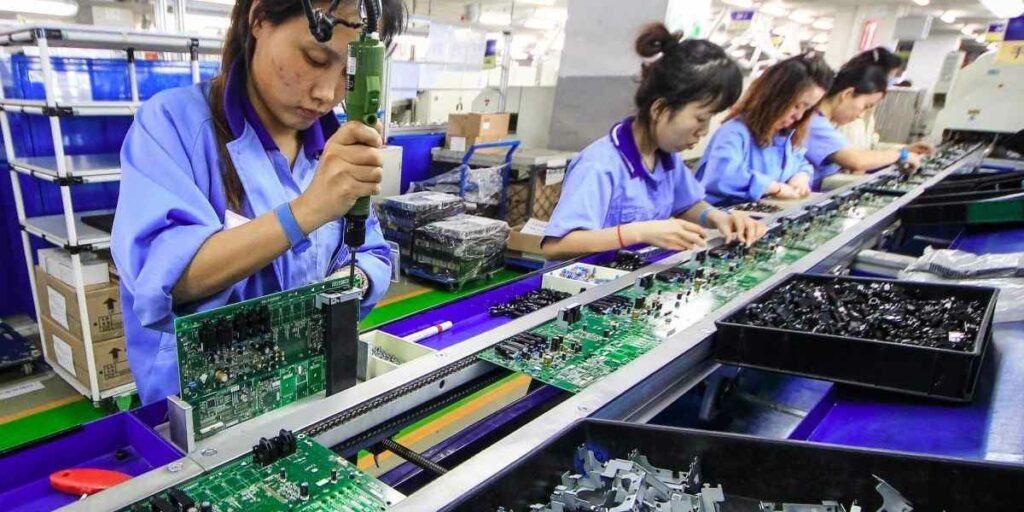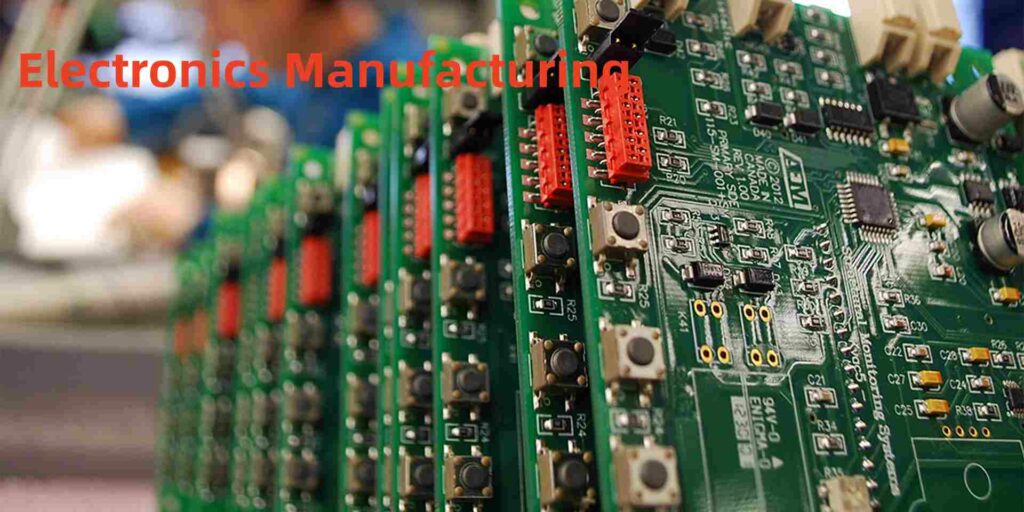Introduction
Electronics contract manufacturing refers to outsourcing production of electronic components, boards, assemblies, systems, and products to a specialized manufacturer. Contract manufacturing provides economies of scale, speed, and expertise that allow companies to bring electronics products to market quickly and efficiently.
In this comprehensive guide, we examine the benefits, services, process flows, supplier selection, pitfalls, and best practices of utilizing electronics manufacturing services providers, also known as EMS companies.
Benefits of Contract Manufacturing
Here are some of the major advantages of outsourcing electronic production:
Focus on Core Competencies
Through contract manufacturing, OEMs can focus engineering resources on product development and innovation rather than manufacturing operations. This allows concentrating on their core competencies.
Reduced Manufacturing Costs
Contract manufacturers achieve significant cost savings through high volumes, optimized facilities and processes, competitive component sourcing, and lower direct labor rates. These savings directly benefit customers.
Speed and Agility
EMS providers can scale production far faster through parallelization, high mix-high volume production, and 24/7 operations. This enables responding quickly to changing demand.
Supply Chain Management
Contract manufacturers handle sourcing, procurement, receiving, and inventory management of thousands of components and commodities. This reduces headaches managing complex supply chains.
Manufacturing Expertise
EMS companies have specialized expertise across fabrication technologies, quality systems, testing methods, regulatory compliance etc. far beyond what any single company can build internally. Customers directly leverage this knowledge and skillset.
Capital Investment
Production machinery, equipment, facilities and their maintenance is highly capital intensive. Outsourcing eliminates the burden of these major investments and upgrades.
By leveraging the scale, resources, and competence of EMS providers, OEMs can minimize overheads and speed time-to-market.
Services Offered

Electronics manufacturing services span the full production cycle:
Design Support
- Design for Manufacturing (DFM) guidance to optimize designs for production.
- Testing and validation of product designs.
- Prototyping of PCBAs, enclosures, tools and fixtures.
Volume Materials Procurement
- Sourcing and procurement of components, commodities and PCBs.
- Vendor qualification and management.
- Custom packaging solutions.
PCB Assembly
- SMT assembly of printed circuit boards.
- Component preparation like taping and reeling.
- Through-hole assembly and soldering.
- Conformal coating.
System Integration
- Configuring and assembly of full systems.
- Interconnect solutions – wiring harnesses, cables.
- Module, enclosure, and chassis assembly.
Post-Production Services
- Programming and configuration.
- Testing, inspection, and diagnostics.
- Packaging, warehousing, and logistics.
- Field service, repair, warranty management.
NPI and Aftermarket Support
- New product introduction (NPI) and ramp-up assistance.
- Redesigns, upgrades, and renewals for existing products.
- Obsolescence monitoring and last-time buys of aging components.
This breadth of services supports the total product lifecycle.
Contract Manufacturing Process Flow
A typical contract manufacturing engagement involves these major steps:
Design Review
The EMS partner reviews product design collateral including schematics, BOMs, assembly drawings, explanations of technology etc. This validates manufacturability.
NPI and Pilot Builds
Low-volume prototyping, pilot runs, and ramp-up builds are executed while processes are optimized prior to mass production.
DFx Analysis
Feedback based on Design for Manufacturing (DFM), Design for Testing (DFT) etc. help refine the product for volume production.
Process Finalization
The optimized assembly, test, and integration processes are documented along with the quality control procedures. The Supply Chain team sources component needs.
Volume Manufacturing
Full-rate production is launched using the approved processes, jigs, fixtures, and programs.
Post-Production Support
Programming, configuration, labeling, packaging, warehousing and order fulfillment occurs based on customer specifications.
Renewal and Obsolescence
Existing product enhancements, upgrades and lifetime buys are supported over time as needed.
Frequent communication and transparency between engineering, manufacturing, quality, and supply chain teams is key throughout the product life-cycle.
Supplier Selection Considerations

Choosing the right contract manufacturing partner involves evaluating:
Technical Capabilities
- Experience with the core production processes needed – SMT, machining, molding, etc.
- Engineering depth in the product domains – power systems, telecom, medical, etc.
Quality
- Maturity of quality systems and controls.
- industry certifications – ISO, FDA, aerospace etc.
Cost Structure
- Bill of Material (BOM) analysis to identify cost reduction opportunities
- Competitive pricing models – unit pricing, annual volumes, multi-project pricing etc.
Supply Chain Infrastructure
- Strength of component sourcing relationships and geographic reach.
- Inventory management systems and transparency.
Program Management
- Structure and sophistication of NPI processes and cross-functional coordination.
- Documented processes and program controls.
Culture
- Customer focus and engineering collaboration mentality.
- Willingness to be transparent and work iteratively to find solutions.
Visiting candidate facilities allows directly assessing capabilities, expertise, and cultural fit.
Pitfalls to Avoid
While contract manufacturing provides tremendous advantages, some potential pitfalls include:
Insufficient Design Review
Failing to adequately review designs upfront leads to manufacturability issues only discovered during pilot builds. This delays production.
Limited Supplier Oversight
Not monitoring supplier quality and financial health can lead to sudden component shortages or quality escapes.
Custom IP and Tooling
Relying heavily on custom tools or processes not easily transferable makes switching suppliers difficult.
Overoptimized Supply Chain
Highly optimized, lean supply chains save cost but have minimal buffer for volatility or shortages.
Delaying Cost Optimization
Putting off value engineering and design-to-cost until late in development increases rework to hit cost goals.
Stretched Resources
Asking one supplier to support too many complex, disparate products strains their ability to provide sufficient focus.
Proactive communication and risk management is key to sidestepping these hazards.
Best Practices

Some tips for maximizing the value of electronics contract manufacturing relationships include:
- Engage EMS expertise early during product development for design feedback.
- Clearly document product and quality requirements upfront.
- Start small with pilot builds to test processes before ramping volumes.
- Maintain regular status reviews of schedule, supply chain, and quality.
- Share visibility into demand forecasts and trends.
- Collaborate to identify cost reduction roadmaps.
- Treat the supplier relationship as a strategic partnership.
By leveraging contract manufacturing strategically, OEMs can minimize overhead, focus on innovation, achieve time-to-market and cost targets, and scale efficiently.
Conclusion
Electronics manufacturing services provide the know-how, assets, supply chain, and scale needed to cost-effectively produce electronic assemblies and systems. An EMS partner serves as an extension of the OEM’s team – providing manufacturing expertise, capacity, and infrastructure. This allows focusing internal resources on design, engineering, and servicing customers. With a well-defined development process, disciplined program management, and strategic supplier relationships, OEMs can utilize electronics contract manufacturing to deliver high quality, feature-rich products faster and more affordably than managing production internally.
Electronics Contract Manufacturing FAQs
Q: What are the main benefits of using a contract manufacturer vs. in-house manufacturing?
A: Cost savings, speed, access to manufacturing expertise, lower capital investment, and supply chain management are the major advantages.
Q: What types of services do contract manufacturers typically provide?
A: Design support, component sourcing, PCB fabrication and assembly, systems integration and testing, logistics, and lifetime product support.
Q: What is the typical process flow when engaging with an EMS partner?
A: Design review, pilot builds, DFx analysis, process finalization, volume ramp-up, ongoing production, product renewals and enhancements.
Q: What are key criteria to evaluate when selecting a contract manufacturer?
A: Technical capabilities, quality systems, cost structure, supply chain infrastructure, program management skills, and company culture.
Q: What are some potential risks or downsides of outsourced manufacturing?
A: Insufficient design review, limited supplier oversight, overcustomization, lean supply chains, delayed cost optimization, and stretched supplier resources.
Q: What best practices help maximize the success of contract manufacturing engagements?
A: Early involvement in design, detailed requirements, phased ramp-up, active status reviews, forecast sharing, cost focus, and treating the supplier as a real partner.





